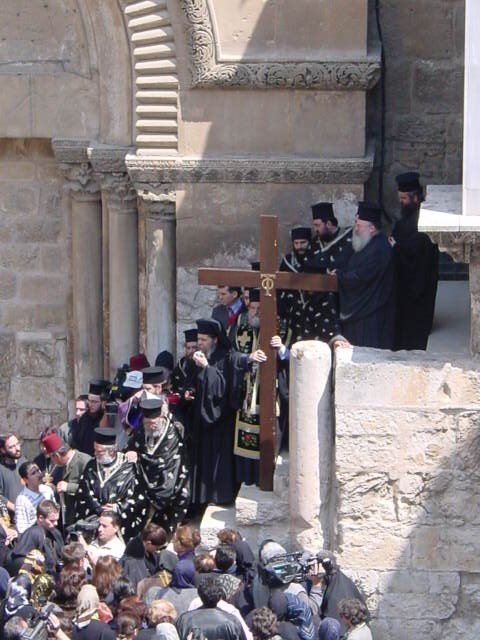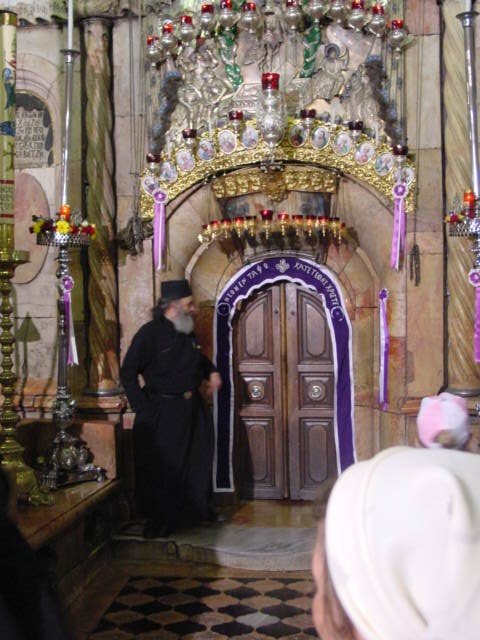May 3, 2002
Good Friday.
An Orthodox woman carries a candle as part of the Good Friday processional.
We joined the Greek procession along the via dolorosa late - the times on the schedule are quite confusing. All times listed within the Holy Sepulchre actually take place one hour later, the Holy Sepulchre not recognizing the "springing forward". In any case, finding a large group of hymn-singing, cross-and-candle-bearing pilgrims was not difficult, and we soon caught up.
An Orthodox woman carries a cross and candle along the Good Friday procession.
This year, because of the political uncertainties, the crowd isn't as big as usual, but it is difficult to imagine what a "usual" year is like among the narrow, winding Old City streets. For the first time since we came here, the vendors along the road look somewhat busy.
The cross carried up the steps to Golgotha.
The procession made its way to the Holy Sepulchre, where the cross was carried to the Greek Orthodox chapel in Golgotha in remembrance of the Crucifixion. The crowds rushed to get upstairs, which Elizabeth and a friend of ours decided to forego. The pushing and jostling for position reminded Marthame of punk rock concerts in college - not exactly a forum for piety.
We met up with our new Australian Orthodox friend, who explained to us the theological significance of icons - to deny them as merely "graven images" (as several iconoclastic periods in the church - including the Reformation - did) is to deny the possibility of the incarnation. Theological conversations abound...
After lunch in the Old City, we headed up to the Russian Church of the Holy Trinity in West Jerusalem. Historically, it was connected with the "Red" churches, those that cooperated with the Communist regime. There is also a "White" Russian church community here, St. Mary Magdalene's convent on the Mount of Olives. We were told that a few years ago, the Russian Orthodox Patriarch came from Moscow to Jerusalem and went to visit the "White" church community at the convent. They refused to open the doors to him - such is the animosity within the Russian Orthodox community.
The door to the Holy Sepulchre is rarely shut, but the Burial of Christ liturgy is one of those moments.
The Church of the Holy Trinity was more sunlit and less gold-laden than we expected. We weren't allowed to take pictures within this church (which is normally closed), but were able to capture some of the elegant liturgical music offered by a women's choir - it's unusual to hear women's voices in Orthodox worship here.
Image of the Burial of Christ at the Holy Sepulchre.
After a short recovery nap, we headed back to the Holy Sepulchre for the Orthodox "Burial of Christ". After processing around the Holy Sepulchre Courtyard with a representation of Christ's body held in a carpet (and covered in flower petals), the Greek Bishops and Patriarch enter the Church. Wherever church leaders go, they are lead by two or three "openers" - men in fezzes pounding long silver-topped walking sticks on the heavy stones to clear the way - a tradition left over from the time of the Ottoman Turkish period.
The crowds swell within the Holy Sepulchre as night approaches.
We were able to get a spot right next to the sepulchre itself, sharing the crowded space with Romanians and other Orthodox faithful. We couldn't see much, though, particularly due to the number of TV cameras and photo media present (as well as dignitaries from the Greek Consulate). We also didn't understand much of the liturgy (since it was in Greek), but at about 1:30 in the morning we thought that they were almost finished. That's when we noticed that they were only halfway through their prayer books. We went home; we clearly don't have the endurance to be high, high church Orthodox.






